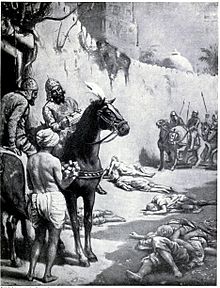Sack of Magadha
This article possibly contains original research. (September 2024) |
The Khalji Raids into Magadh,[1][2][3] was a significant military campaign of the Ghurid Empire led by the Ghurid commander Bakhtiyar Khalji. He successfully captured Bihar, incorporating it into the Ghurid Empire, before proceeding with his invasion of Bengal.[4][5]
The Conquest
[edit]
Muhammad Bakhtiyar Khalji advanced towards Bihar with a mere 200 soldiers, yet he accomplished the relatively easy capture of one of its most heavily fortified forts, Udantapuri.[6][7] While local inhabitants did resist the Ghurid general and his forces, resulting in significant casualties on both sides. Despite emerging from his fort to engage in battle with great courage, the ruler was ultimately defeated and killed in the ensuing confrontation with the Khalji Commander.[8][9]
Destruction of Nalanda and Vikramshila
[edit]It is highly likely that during this particular conquest, as recorded by the Tibetan chronicler Taranath in the 15th century, Bakhtiyar also seized the monastic cities of Vikramsila and Nalanda, and proceeded to raze them to the ground. He mercilessly slaughtered all the residents and plundered a great amount of riches, which he then delivered to Sultan of Delhi, Qutubuddin Aibak.[10]
Muhammad Bakhtiyar Khalji demolished ancient centers of learning at Nalanda and Vikramshila before orchestrating a widespread massacre upon entering the fort, historical evidence suggests otherwise. The prevailing consensus among historians refutes the portrayal of Bakhtiyar Khalji as a merciless and bloodthirsty military leader. Instead, a more nuanced understanding reveals that Bakhtiyar Khalji's actions were not marked by cruelty or ruthlessness, challenging the traditional narrative that has painted him in an unfavorable light.[7]
The three kings of the Guptas of Jayapura dynasty who likely lived in the first half of the 12th century. They were vassals of the Palas, as Monghyr was part of the Pala kingdom until the mid-12th century. After the decline of the Palas, Rajadityagupta declared independence. His son, Krishnagupta, passed away before him. Rajadityagupta was succeeded by his grandson, Sangramagupta. It is believed that Sarhgramagupta, another ruler of the Guptas, was a contemporary of Lakshmanasena. The Guptas' power was likely ended by Muhammad Bakhtyär Khalji in the early 13th century during the reign of Sangramagupta.[11]
References
[edit]- ^ Scharfe, Hartmut (2002). Handbook of Oriental Studies. BRILL. p. 150. ISBN 978-90-04-12556-8.
- ^ Ray, Aniruddha (2016-09-13). Towns and Cities of Medieval India: A Brief Survey. Taylor & Francis. p. 161. ISBN 978-1-351-99731-7.
- ^ Choubey, Asha Shukla (2021-11-29). Crafts and Craftsmen in Pre-colonial Eastern India: Technology and Culture. Taylor & Francis. ISBN 978-1-000-47769-6.
- ^ Islam in India. Vikas Publishing House. 1989. p. 269.
- ^ Qasem, M. A. (1958). Muslim Rule in India: From the Invasion of Muhammad-bin-Qasim to the Battle of Plassey, 712-1757 A.D. Z.A. Qasem. p. 67.
- ^ Siddiqi, Iqtidar Husain (2010). Indo-Persian Historiography Up to the Thirteenth Century. Primus Books. p. 134. ISBN 978-81-908918-0-6.
- ^ a b Khan, Muhammad Mojlum (2013-10-21). The Muslim Heritage of Bengal: The Lives, Thoughts and Achievements of Great Muslim Scholars, Writers and Reformers of Bangladesh and West Bengal. Kube Publishing Ltd. p. 15. ISBN 978-1-84774-062-5.
- ^ Samaddar, Jogindra Nath (1990). The Glories of Magadha. K.P. Jayaswal Research Institute. pp. XXXIII–XXXVI.
- ^ O'malley, L. S. S. (2007). Bihar And Orissa District Gazetteers : Monghyr. Concept Publishing Company. p. 33. ISBN 978-81-7268-135-7.
- ^ Srivastava, Ashok Kumar (1972). The Life and Times of Kutb-ud-din Aibak. Govind Satish Prakashan. pp. 145–150.
- ^ S. Ramakrishnan (2001). History and Culture of the Indian People, Volume 05, The Struggle For Empire. Public Resource. Bharatiya Vidya Bhavan. p. 49.
This article needs additional or more specific categories. (September 2024) |
